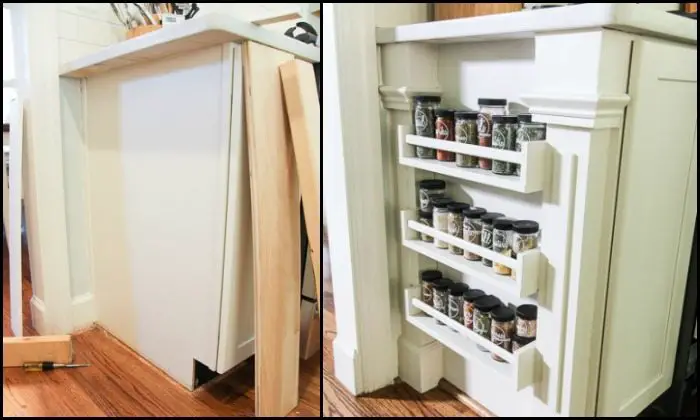If you enjoy cooking, then you know how important it is to be able to find that bottle of seasoning precisely when you need it. A built-in spice rack near your cooking space is the answer to this problem.
Have you been looking for a way to keep your spices in order? If so, then you’re going to enjoy this project.
Because here’s a spice rack idea that just might suit your kitchen. It’s space-saving, easy to build, and beautiful too!

This DIY spice rack uses the dead space at the end of a counter, which many kitchens usually have. If you don’t have a pantry or don’t want congested cabinets, you can use this idea for your spices instead.
This project is an Ikea hack that uses three Bekvam spice racks. They are made from solid wood and are pre-made, making the entire project even easier. Of course, if you have some nice pieces of wood in your storage, then you can DIY the spice racks yourself.
Is this going to be your next DIY kitchen project?
Contents
Building a Built-In Spice Rack
Transforming Ikea’s Bekvam spice racks into a sleek, built-in spice rack enhances kitchen organization and adds a custom touch to your culinary space. Follow this guide to create a built-in spice rack tailored to your kitchen’s aesthetic and functional needs.
Materials and Tools:
- Ikea Bekvam Spice Racks
- Sandpaper (fine-grit)
- Primer (suitable for the wood)
- Paint or wood stain (color of your choice)
- Paintbrushes or a small roller
- Wood screws (length appropriate for your cabinet or wall thickness)
- Screwdriver or drill
- Measuring tape
- Level
- Pencil
- Optional: wood glue, for extra stability
- Optional: varnish, to seal and protect the painted or stained wood
Steps
- Preparation
- Begin by preparing your workspace, laying down a drop cloth or newspapers to protect surfaces from paint or stain.
- Unpack the Bekvam spice racks and arrange all parts on your workspace.
- Customizing the Structure
- To fit the racks into a custom design, layer scrap pieces of plywood to the face of your supporting structure, such as a 2×4, and frame the sides with lattice strips. This not only widens the sides for a perfect fit but also hides any rounded edges.
- Consider the overall design where the spice rack will be installed. If planning to wrap the top and bottom in trim, ensure the depth aligns with existing features, like a custom bookshelf.
- Sanding:
- Use fine-grit sandpaper to lightly sand the surface of the Bekvam racks. This step ensures the primer and paint adhere properly to the wood.
- Wipe down the racks with a clean cloth to remove dust after sanding.
- Priming:
- Apply a coat of primer to the sanded racks. Choose a primer suitable for wood and the type of paint you plan to use.
- Allow the primer to dry completely, according to the manufacturer’s instructions.
- Painting or Staining:
- Once the primer is dry, apply your chosen paint or stain with a brush or roller. For a built-in look, match the color to your kitchen cabinets or walls.
- Apply a second coat if necessary, allowing each coat to dry thoroughly.
- Optional Varnishing:
- If desired, apply a varnish over the painted or stained racks for additional protection. This step is especially recommended for kitchens with high humidity or frequent spice spills.
- Planning the Installation:
- Decide on the location for your built-in spice rack. Common choices include the side of a cabinet, the end of a counter, or a pantry wall.
- Use the measuring tape and pencil to mark the desired position of the racks. Ensure the area is level.
- Mounting the Racks:
- Pre-drill holes in the marked positions to make the installation easier and to prevent the wood from splitting.
- Secure the Bekvam racks to the chosen spot using wood screws. If the racks feel unstable, you can also apply wood glue to the back before screwing them in place.
- Finishing Touches:
- Once the racks are securely attached, fill them with your spice bottles. Arrange the spices in a way that makes them easily accessible and visually appealing.
- Use a level to ensure that the racks are perfectly horizontal.
- Enjoy Your Built-In Spice Rack:
- Step back and admire your handiwork. This built-in spice rack not only adds functionality to your kitchen but also enhances its overall look with a custom touch.
By thoughtfully combining structural modifications and aesthetic enhancements, you create a spice rack that seamlessly integrates with your kitchen’s design, offering both beauty and utility.
Achieve a Cohesive Look with Custom Labels on Spice Jars
Switching to uniform spice containers gives your built-in spice rack a cohesive look and makes it easier to organize and identify your spices. The magic lies in the details, my friend. When you take the time to label each container clearly with the spice name and expiration date, you’re not just enhancing the aesthetic appeal but significantly boosting the functionality of your kitchen.
Here’s how you can transform your spice collection into a cohesive masterpiece:
- Cohesion
- Choose a design that matches your kitchen’s aesthetic. Stick to a single font style and color palette to ensure each label complements the others perfectly.
- Uniform containers create a streamlined appearance, transforming your spice rack from chaotic to curated.
- Leverage Free Resources
- Many online platforms offer free customizable label templates. Whether you have a Cricut, Silhouette, or any other cutting machine, you can easily download and use these templates to make labels that fit your jars perfectly.
- Choose Durable Materials
- Opt for waterproof and oil-resistant paper or vinyl to keep your labels looking fresh and clean, even with frequent use.
- Emphasize Readability
- Ensure that your labels are easy to read at a glance by selecting clear, bold fonts with good contrast against the background.
- With clear labels, you can quickly grab the spice you need, saving time during meal prep.
- Highlight Details
- Consider adding supplementary information, like the date of purchase or expiration, to make your labels not only attractive, but functional.
- Noting expiration dates ensures you always use fresh ingredients, elevating the flavors of your dishes.
By focusing on these details, you’ll not only keep your spices organized but also add a touch of personalized elegance to your kitchen space.
Click on any image to start lightbox display. Use your Esc key to close the lightbox. ![]()
Built-In Spice Rack Ideas
Details can enhance one’s enjoyment and satisfaction by providing a sense of completeness and fulfillment in various aspects of life. Paying attention to details is crucial because they enrich our experiences and can contribute significantly to personal happiness.
Utilize pantry door space efficiently with a built-in spice rack. This clever solution creates a convenient storage area for spices, keeping them neat and within reach. Customize the rack to fit your needs, maximizing space in any kitchen. Save counter and cabinet space while enhancing the pantry door’s functionality and appearance.
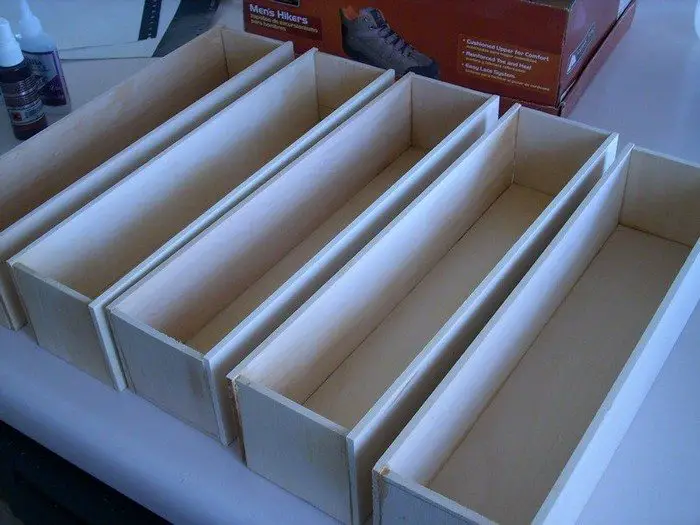


Under Cabinet Spice Rack
An under cabinet spice rack maximizes space below upper kitchen cabinets, blending in with your cabinetry for discreet storage. It keeps spices handy while cooking, custom-designed to fit your kitchen’s dimensions with a slide-out or fold-down feature for easy access.
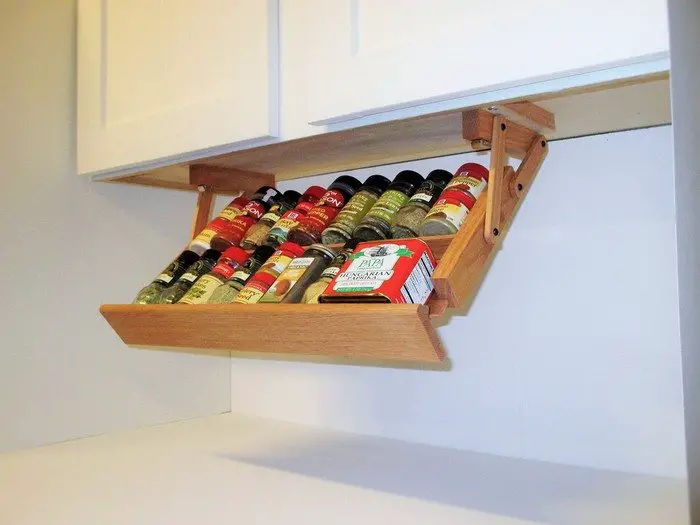
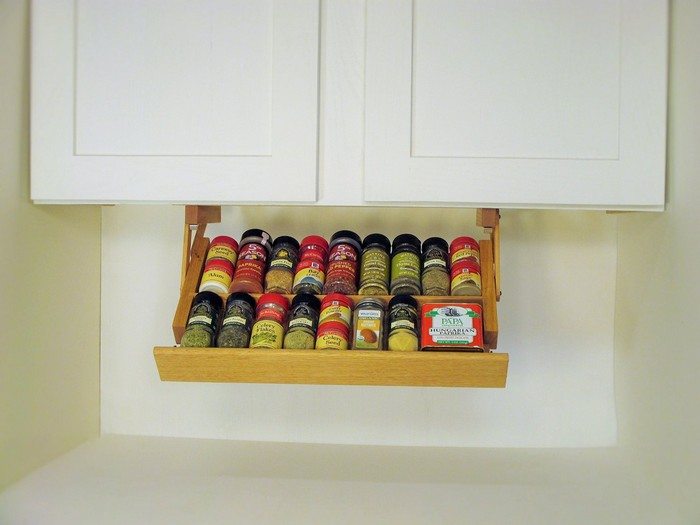

Consider a test tube spice rack for a modern twist on traditional spice storage. This design uses clear tubes to display spices, mounted on a wall or inside a cabinet door. Perfect for those who appreciate a minimalist look in their kitchen.
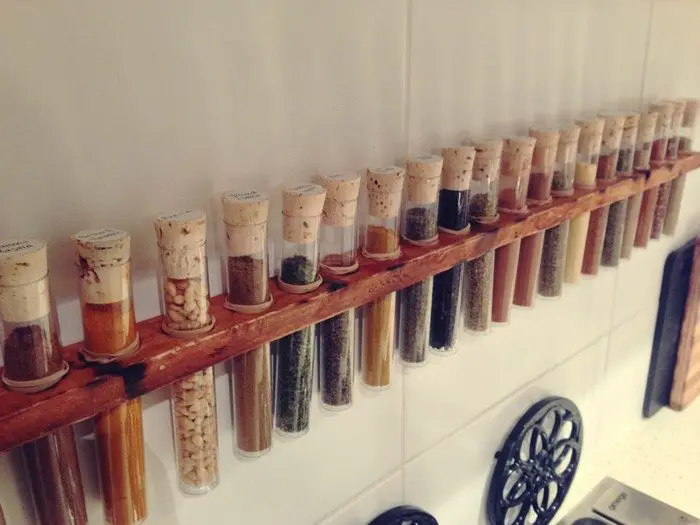


Cabinet Door Spice Clips
Maximize cabinet space with spice clips for a built-in spice rack. Easily access and view spices without using shelf space. Ideal for small kitchens to efficiently store spices hidden yet reachable.

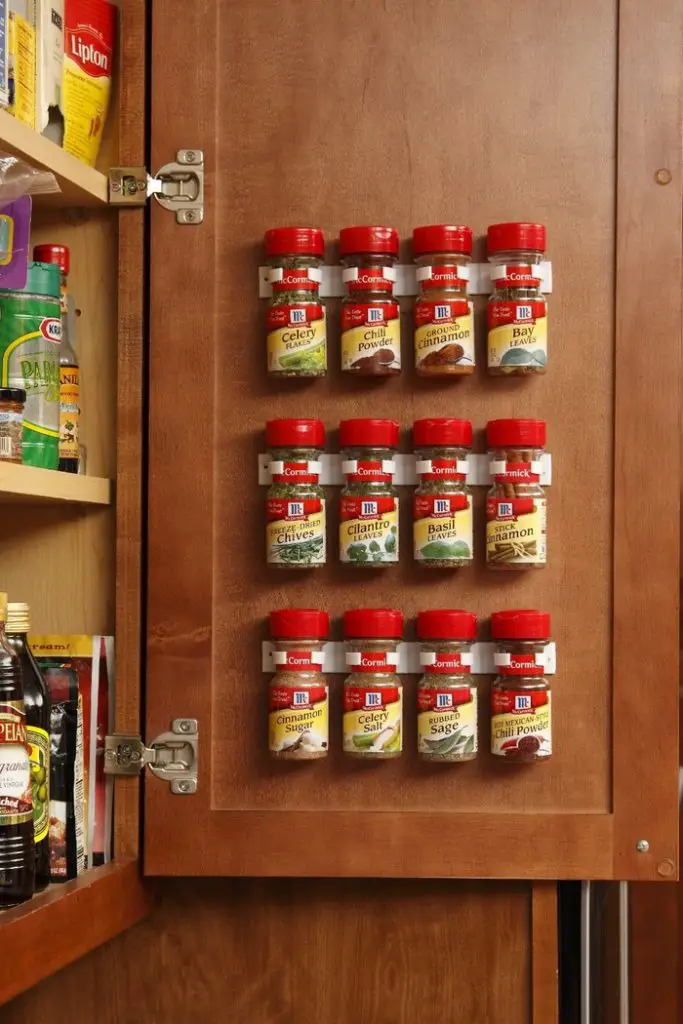
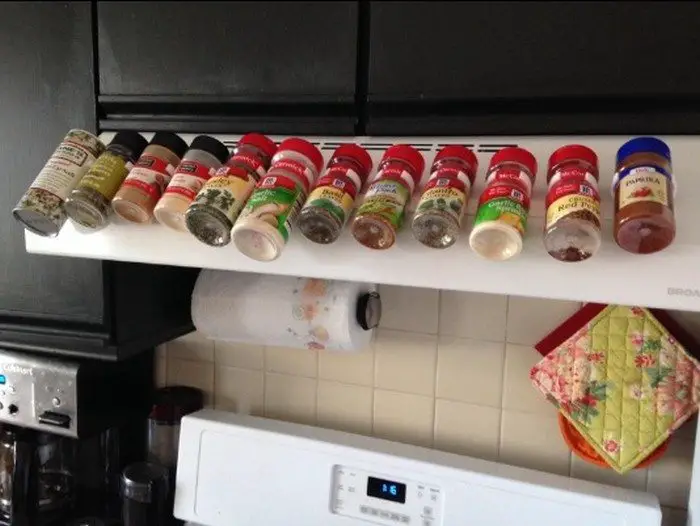
Spice Organizer
A spice organizer keeps spices neatly arranged in drawers or cabinets, with dividers for sorting by type or alphabetically. It helps maintain a clutter-free kitchen and adds functionality to your cooking space.
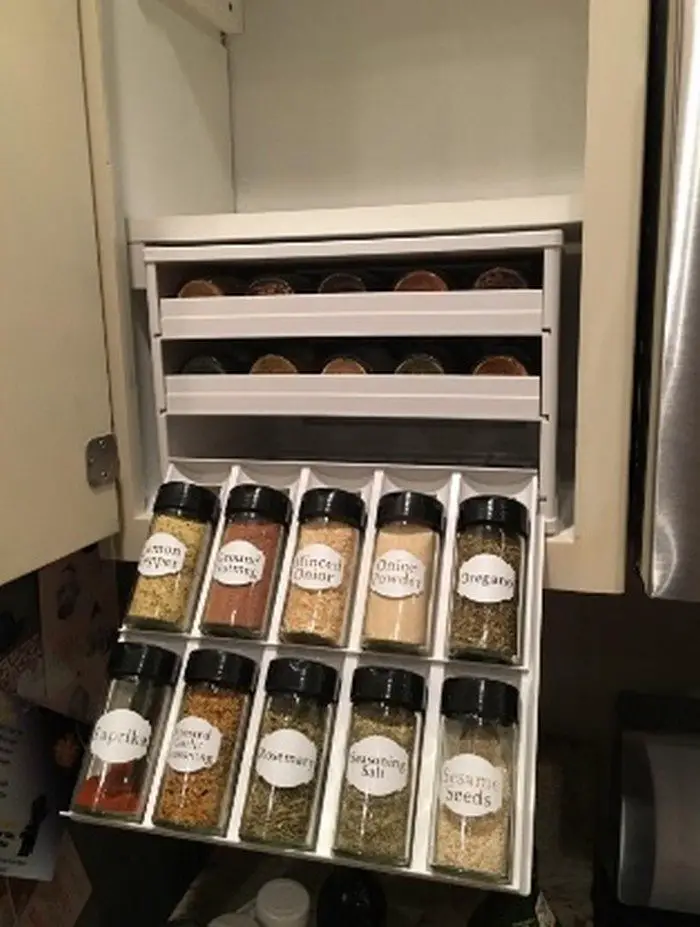
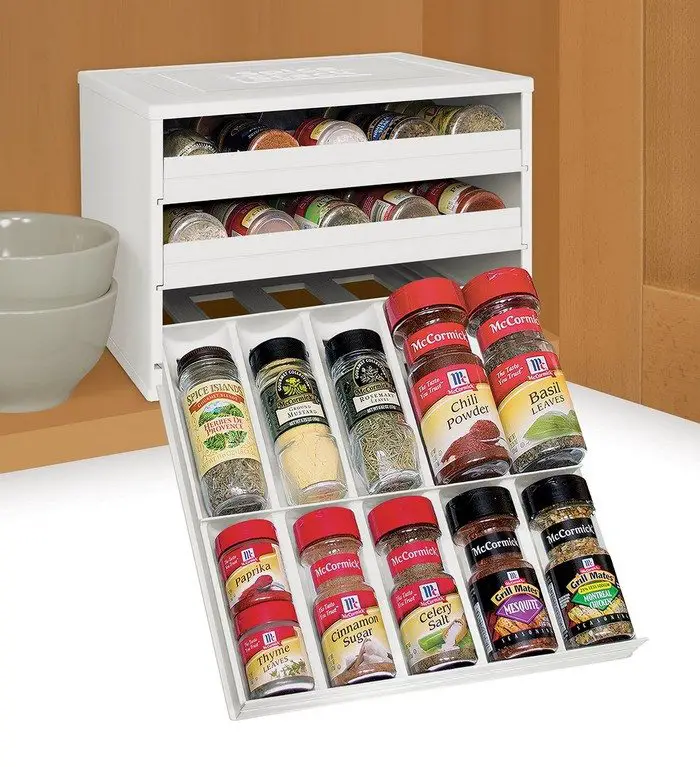
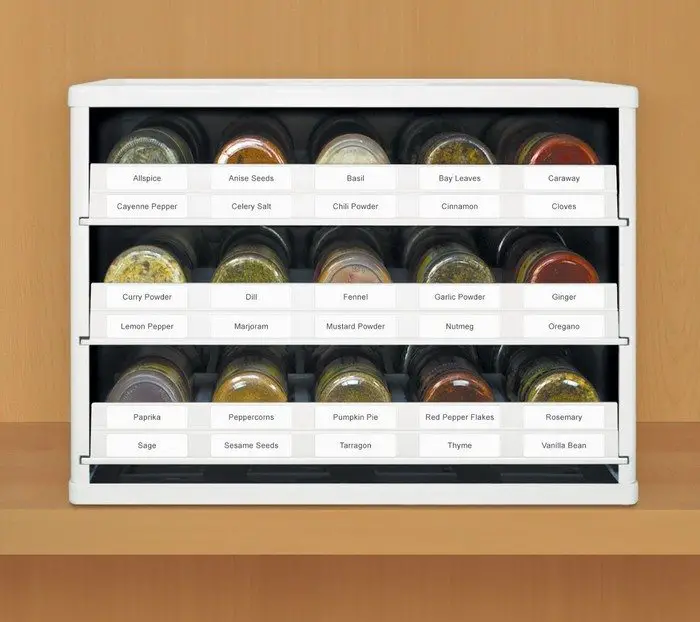
A pull-down spice rack is a built-in solution for upper cabinets that can be angled down for easy viewing and selection of spices. Ideal for limited mobility or small kitchens, this rack enhances accessibility and organization without the need for stepping stools or cabinet reshuffling.
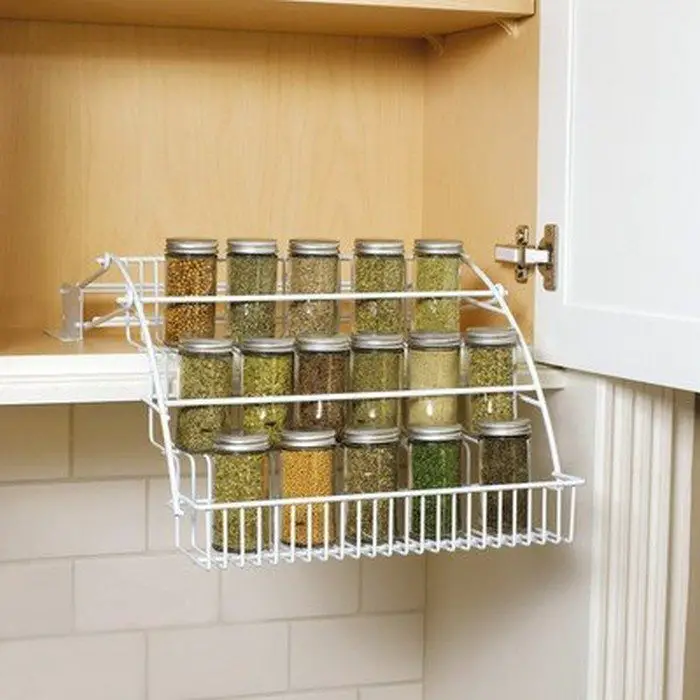
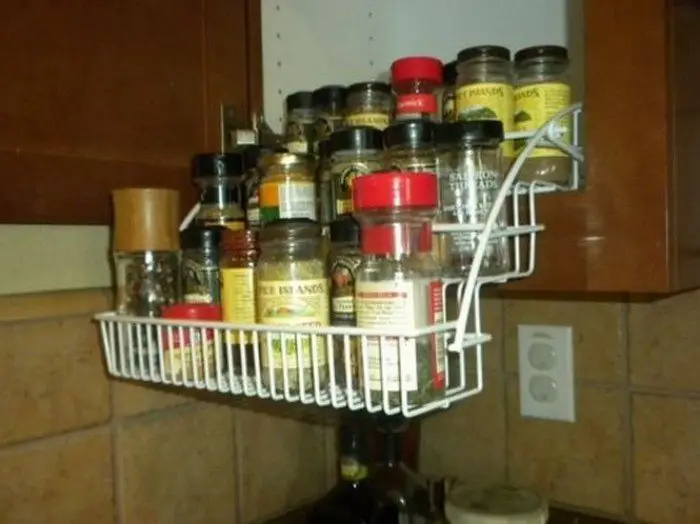
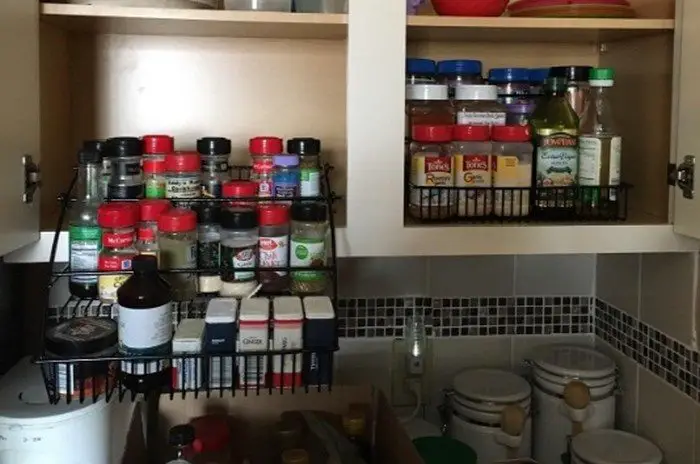
Maximizing Small Kitchen Spaces
Small kitchens present unique challenges when it comes to organization and storage. However, with some creativity and strategic planning, you can transform your cramped kitchen into a highly efficient and stylish space. One effective way to achieve this is by incorporating built-in spice racks and other smart storage solutions.
These ideas save valuable counter and cabinet space and add a custom touch to your kitchen.
Use Vertical Space Wisely
- Built-In Spice Racks: Maximize your kitchen’s vertical space by installing built-in spice racks on unused wall areas or the sides of cabinets. This not only keeps your spices organized and within reach but also frees up precious cabinet space for other essentials.
- Hanging Storage: Utilize the space above your counter by installing hanging storage solutions, such as pots and pans racks. This keeps your cookware handy while saving cabinet space for other items.
Optimize Cabinet and Drawer Space
- Sliding Cabinet Organizers: Equip your cabinets with sliding organizers to make it easier to access pots, pans, and small appliances without having to dig through cluttered shelves.
- Drawer Dividers: Use drawer dividers to neatly organize utensils, cutlery, and smaller kitchen gadgets. This helps maximize drawer space and keeps everything within easy reach.
Embrace Multi-Functional Furniture
- Foldable Kitchen Table: A foldable table can serve as an additional prep area when needed and be tucked away when not in use, offering flexibility in a small kitchen.
- Bar Cart: A bar cart can double as extra storage for kitchen essentials and a mobile serving station, making it a versatile addition to small spaces.
Invest in Wall-Mounted Appliances
- Wall-Mounted Microwave and Oven: Installing your microwave and oven within your cabinetry or mounted on the wall can save significant counter space, making your kitchen appear larger and more open.
Implement Underutilized Areas
- Under Cabinet Spice Rack: An under cabinet built-in spice rack utilizes the often-overlooked space beneath your upper cabinets, providing a hidden yet accessible area for your spices.
- Toe-Kick Drawers: The space beneath your lower cabinets can be converted into toe-kick drawers, offering additional storage for flat items like baking sheets and cutting boards.
Integrating these strategies lets you maximise every inch of your small kitchen. Built-in spice racks and other innovative storage solutions enhance your space’s functionality and create a more organized and aesthetically pleasing kitchen environment.
Spice Rack Maintenance and Organization Tips
Keeping your spice rack organized and well-maintained is crucial for any kitchen, allowing for easy access and optimal freshness of your spices. Built-in spice racks, in particular, offer a seamless and efficient way to store your seasonings, but like any storage solution, they require some upkeep.
Follow these tips to ensure your built-in spice rack remains both functional and beautiful.
Regular Cleaning
- Keep It Clean: Regularly cleaning your built-in spice rack helps maintain its appearance and functionality. Wipe down the shelves with a damp cloth to remove dust and spice residue. For wooden racks, use a wood cleaner to preserve the finish.
- Deep Cleaning Schedule: Set a schedule for a deep clean of your built-in spice rack at least twice a year. This involves removing all the spices, vacuuming any debris from the shelves, and cleaning each nook and cranny with a suitable cleaner. For sticky residue, a solution of warm water and mild dish soap works well.
- Protective Liners: Consider using washable, non-adhesive shelf liners on your built-in spice rack. These liners can catch spills and dust, making cleanup easier. They can be easily removed, washed, and replaced, keeping the rack cleaner over time.
- Natural Cleaning Solutions: For a more natural cleaning approach, use a mixture of vinegar and water to wipe down the spice rack. This solution is effective for cleaning without leaving harmful residues, ensuring your spices remain uncontaminated.
Spice Organization
- Categorize Your Spices: Organize your spices in a way that makes sense for your cooking habits. You might categorize them by usage (baking vs. cooking), by cuisine, or alphabetically. This system will make it easier to find what you need quickly.
- Use Uniform Containers: Switching to uniform spice containers gives your built-in spice rack a cohesive look and makes it easier to organize and identify your spices. Label each container clearly with the spice name and expiration date.
- Digital Inventory Tracking: Leverage technology to keep track of your spices by using a spreadsheet or a kitchen inventory app. This digital record can help you quickly see what you have, what’s running low, or what’s expired without manually sorting through every bottle.
- Color Coding System: Implement a color-coding system for your spice containers. Use different colored labels or caps to denote categories, such as herbs, baking spices, hot spices, etc. This visual system can speed up your cooking process by making grabbing what you need at a glance easier.
- Adjustable Shelf Heights: If possible, adjust the shelf heights in your built-in spice rack to accommodate various container sizes. This flexibility allows you to maximize the space and accommodate bulkier items without wasting space or overcrowding the shelves.
- Use of Clear Containers: If not already mentioned, transitioning to clear spice containers can significantly enhance organization. Clear containers allow you to see the contents and quantity at a glance, eliminating the need to open each one to check what’s inside or how much remains.
Maximizing Freshness
- Check Expiration Dates: Regularly check the expiration dates of your spices and discard any that are past their prime. Fresh spices make a significant difference in cooking, and keeping them up-to-date ensures your dishes are always flavorful.
- Store Spices Properly: Ensure your built-in spice rack is located away from heat sources and direct sunlight, as these can degrade the quality of your spices. A cool, dark place is ideal for preserving their flavor and longevity.
- Airtight Containers: Ensure all spices are stored in airtight containers to prevent exposure to air, which can degrade quality and flavor. Airtight containers also protect spices from moisture and pests, extending their shelf life.
- Buy in Small Quantities: Opt to purchase spices in small quantities that you can use quickly. This approach ensures that spices retain their potency and flavor, contributing to better-tasting dishes.
- Use Silica Gel Packets: Consider placing a silica gel packet in your spice containers to absorb any excess moisture. This tip is particularly useful in humid climates where moisture can cause clumping or spoilage.
Making the Most of Your Space
- Rotate Frequently Used Spices: Keep the spices you use most often at the front of your built-in spice rack for easy access. Rotate less frequently used spices to the back but ensure they are still reachable when needed.
- Incorporate Expandable or Sliding Shelves: If your built-in spice rack allows, incorporate expandable or sliding shelves to maximize space and accessibility. This feature is particularly useful for deep cabinets where spices can get lost in the back.
- Vertical Spice Racks: If you haven’t already utilized vertical spaces, consider adding additional tiers to your built-in spice rack. Vertical racks can dramatically increase storage capacity without expanding the footprint.
- Magnetic Spice Containers: Use magnetic spice containers for metal surfaces or add a magnetic spice rack inside cabinet doors. These can stick directly to the surface, freeing up shelf space in your built-in rack for other items.
- Utilize Door Space: If your built-in spice rack is part of a cabinet, make the most of the cabinet door by adding shallow shelves or clips for additional spice storage. This effectively doubles your storage area without impeding the functionality of the rack.
Regular Inventory
- Conduct Regular Spice Audits: Every few months, take inventory of your spices. This helps you keep track of what you have and prevents overbuying or duplication. It’s an excellent opportunity to wipe down the rack and reorganize, if necessary.
- Seasonal Check-ups: Align spice rack audits with seasonal changes, a natural time for kitchen turnover. This routine helps ensure that your spice collection is fresh and relevant for seasonal cooking.
- Spice Borrowing Log: Keep a borrowing log near the rack if you share spices with roommates or family members. This simple tracking method ensures everyone knows what’s been used and what needs replacing, keeping the inventory up-to-date.
- Labeling with Purchase Dates: Beyond expiration dates, label spices with their purchase dates. This information can help you prioritize using older spices first and assess how quickly you use certain spices to adjust future purchases.
By implementing these maintenance and organization tips, your built-in spice rack will serve as a functional and aesthetically pleasing part of your kitchen. Regular upkeep ensures the longevity of your spices and enhances your cooking experience, making meal preparation easier and more enjoyable.

